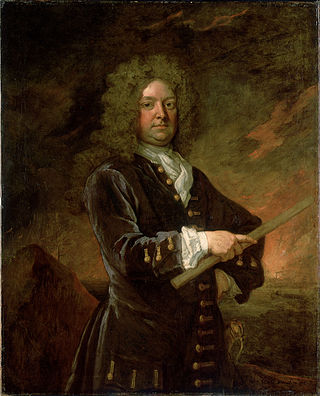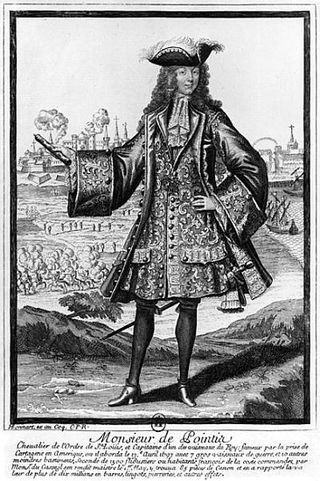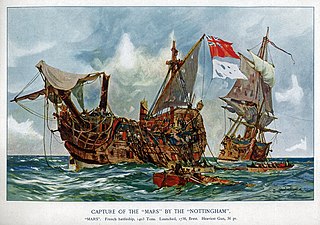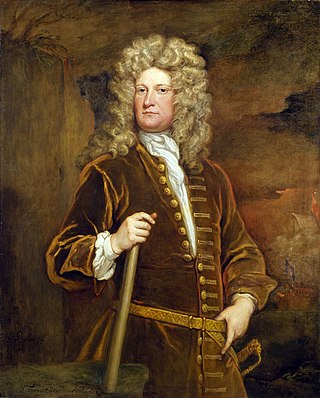
Admiral of the Fleet Sir George Rooke was an English naval officer. As a junior officer he saw action at the Battle of Solebay and again at the Battle of Schooneveld during the Third Anglo-Dutch War. As a captain, he conveyed Prince William of Orange to England and took part in the Battle of Bantry Bay during the Williamite War in Ireland.

The battle of Málaga, also known as the battle of Vélez-Málaga, was a major fleet action which took place during the War of the Spanish Succession between an Anglo-Dutch fleet and a Franco-Spanish naval force on 24 August 1704. Both sides fought an intense engagement before the Anglo-Dutch fleet withdrew the next day. The French subsequently returned to Toulon, transforming the battle from a tactical stalemate into a strategic defeat, as they would not put out to sea again for the duration of the conflict. Occurring soon after the Anglo-Dutch capture of Gibraltar a few weeks prior, the battle served as one of the numerous engagements which took place for control over the settlement during the war.

Francisco Castillo Fajardo, 2nd Marquis of Villadarias was a Spanish military officer and nobleman.

Alain-Emmanuel de Coëtlogon was a Marshal of France during the reign of Louis XIV and Louis XV.

Admiral of the Fleet Sir John Leake was a Royal Navy officer and politician. As a junior officer he saw action at the Battle of Texel during the Third Anglo-Dutch War. He then distinguished himself when he led the convoy that broke the barricading boom at Culmore Fort thereby lifting the siege of Derry during the Williamite War in Ireland. As a captain he saw action in some of the heaviest fighting at the Battle of Barfleur and was also involved in a successful attack on the French ships at the Battle of La Hogue during the Nine Years' War.

Bernard Desjean, Baron de Pointis was a French Navy officer and nobleman.

HMS Nottingham was a 60-gun fourth-rate ship of the line of the Royal Navy, built at Deptford Dockyard and launched on 10 June 1703. She was the first ship to bear the name.

HMS Hampton Court was a 70-gun third rate ship of the line of the Royal Navy, launched at Deptford Dockyard in 1678. Her initial commission was to move her to Chatham where she spent in the next ten years in Ordinary. She held an active commission for the War of the English Succession, participating in the Battles of Beachy Head and Barfleur. She was rebuilt at Blackwall in 1699/1701. During the War of Spanish Succession she served mainly in the Mediterranean. In 1707 she was taken by the French and incorporated into the French Navy for four years. She was sold to the Spanish in 1712. She was wrecked in Spanish service off the coast of Florida in a hurricane in 1715.
HMS Berwick was a 70-gun third rate ship of the line of the Royal Navy, built at Chatham Dockyard during 1677/1679. After completion she was placed in Ordinary for 10 years. She was commissioned for the War of the English Succession 1689-1697, participating in the battles of Beachy Head and Barfleur. She was rebuilt between 1697 and 1700. She was commissioned for the War of Spanish Succession 1702-1712, participating in the battles of Vigo Bay, Capture of Gibraltar and Velez Malaga. placed in Ordinary in 1712, she was converted to a hulk at Portsmouth in 1715 before being broken in 1742.

HMS Essex was a 70-gun third rate built by Sir Henry Johnson of Blackwall in 1678/79. During the War of the English Succession she fought in the last major action. She was rebuilt in 1699/1700. During the War of Spanish Succession she fought at Vigo Bay, the Capture of Gibraltar and Velez Malaga. She also fought at the Battle off Passero in 1718. She was rebuilt again in 1736-40. She was in action off Toulon in 1744. She was active in the Channel and against French ports during the Seven Years War. She fought at Quiberon Bay in 1759. She was wrecked in Quiberon Bay in November 1759.

HMS Expedition was a 70-gun third-rate ship of the line built at Portsmouth Dockyard in 1677/79. She was in active commission during the War of the English Succession participating in the battles of Beachy Head and Barfleur. She was rebuilt in 1699. Again, for the War of Spanish Succession she was in commission for the operation at Cadiz then returned to England where she sat for two years. She was in the Mediterranean for the Battle of Marbella in 1705. She then went to the West Indies and fought in Wager's action off Cartagena in 1708. She was rebuilt in 1709-14 to the 1706 Establishment. She spent her time split between the Baltic and as guard ship at Portsmouth before being broken at Portsmouth in 1736. She was rebuilt in 1736/40 at Deptford Dockyard.
HMS Grafton was a 70-gun third rate built at Woolwich Dockyard in 1677/79. She was delivered to Chatham and placed in Ordinary in 1679. She was commissioned in 1683 to participate in the evacuation of Tangier, Morocco. She served during the War of the English Succession fighting in the Battles of Beachy Head and Barfleur. She was rebuilt in 1699/1701. She was in active commission during the War of Spanish Succession. She fought in the Battle of Vigo, the capture of Gibraltar and the Battle of Velez Malaga. She was taken by the French in 1707 and incorporated into the French Navy. Finally, being broken at Brest in 1744.

HMS Kent was a 70-gun third rate ship of the line built by Sir Henry Johnson of Blackwall in 1677/79. She served during the War of English Succession 1699 to 1697, participating in the Battle of Barfleur. She was rebuilt in 1697/99. She served during the War of Spanish Succession 1702 to 1712 and partook in the Battles of Vigo and Velez-Malaga. She partook in the Battle of Passaro then served during the short war with Spain, December 1718 to February 1720. She was rebuilt in 1722/26. She spent the next thirteen years as a guard ship at Portsmouth. In the 1740s, she was off Cape Finisterre then in the West Indies. She returned home and was finally broken in 1744.
HMS Calpe was the former 14-gun polacca San José of the Spanish Navy, originally built in 1796 in Greece. The British captured her in 1800 and commissioned her as a sloop-of-war. She served at the Battle of Algeciras Bay before the Navy sold her in 1802. She underwent repairs and reappeared as a merchantman in the 1805 registers; however, she wrecked at the Dardanelles in 1805.

The twelfth siege of Gibraltar was fought between September 1704 and May 1705 during the War of the Spanish Succession. It followed the capture in August 1704 of the fortified town of Gibraltar, at the southern tip of Spain, by an Anglo–Dutch naval force led by Sir George Rooke and Prince George of Hesse-Darmstadt. The members of the Grand Alliance, the Holy Roman Empire, England, the Netherlands, Pro-Habsburg Spain, Portugal and Savoy, had allied to prevent the unification of the French and Spanish thrones by supporting the claim of the Habsburg pretender Archduke Charles VI of Austria as Charles III of Spain. They were opposed by the rival claimant, the Bourbon Philip, Duke of Anjou, ruling as Philip V of Spain, and his patron and ally, Louis XIV of France. The war began in northern Europe and was largely contained there until 1703, when Portugal joined the confederate powers. From then, English naval attentions were focused on mounting a campaign in the Mediterranean to distract the French navy and disrupt French and Bourbon Spanish shipping or capture a port for use as a naval base. The capture of Gibraltar was the outcome of that initial stage of the Mediterranean campaign.
Sir Edward Whitaker was an officer of the Royal Navy. He served during the War of the Spanish Succession and is known for his role in the Capture of Gibraltar and the Battle of Málaga in 1704.
Events from the year 1705 in France

Rear-Admiral Sir Thomas Dilkes was an officer in the Royal Navy.

Rear-Admiral Sir Thomas Hardy was a Royal Navy officer of the late 17th and early 18th centuries. Having joined the navy sometime before 1688, Hardy's career was supported by Captain George Churchill, whom he served as first lieutenant during the Battle of Barfleur in 1692. Promoted to captain in 1693, Hardy served in the Channel Islands and off the coast of England until 1702 when he was given command of HMS Pembroke off the coast of Spain. He fought at the Battle of Cádiz, and subsequently discovered the location of the Franco-Spanish fleet through the intervention of his chaplain, which resulted in the Battle of Vigo Bay. Hardy was knighted for his services.
Captain Sir Andrew Leake was a Royal Navy officer of the late seventeenth and early eighteenth centuries, who distinguished himself at the Battle of Vigo Bay, during the War of the Spanish Succession. From Lowestoft, Leake joined the navy in 1688 under the patronage of John Ashby. Promoted to commander, Leake fought under Ashby as a supernumerary at the Action at La Hogue in 1692. His services at La Hogue brought him promotion to captain, and a series of commands that culminated in 1702 with Leake joining HMS Torbay. At Vigo Bay later that year Torbay broke the boom protecting a Franco-Spanish treasure fleet, resulting in the capture or destruction of the entire fleet. Leake was knighted for this, and went on to command HMS Grafton at the Capture of Gibraltar in 1704. He was mortally wounded at the Battle of Málaga later the same year.















